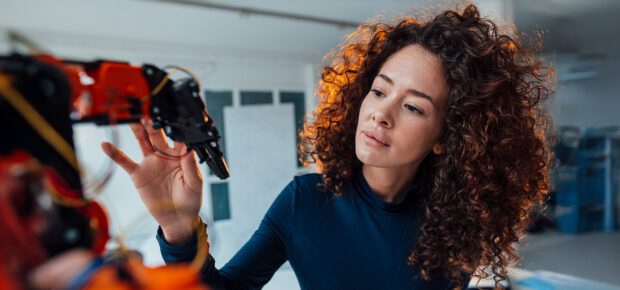November 12, 2024
Imagine working side by side with a robot that understands the way you move and senses exactly how much force you are using to lift a box, or how gently you are grasping a tool. That is the future we are building with human-robot teaming.
Robots are becoming our teammates, whether they are used in manufacturing, hospitals or even for everyday tasks like assisting someone with mobility challenges. However, for this teaming to be successful, robots must be able to recognize the strength and subtle movements humans make on a daily basis.
For example, they must be able to recognize how gently you hold something delicate or how forcefully you press down when chopping vegetables. The challenge is that it is difficult to predict these hand forces. Think about how different it feels to lift a coffee mug versus carrying a box of books. Your movements vary depending on the task; it takes more than a hunch to have a machine recognize that variance. It is like teaching someone who has never cooked before how to knead dough. Too little pressure would cause it to crumble, and too much pressure will damage the texture.
That is where a new approach that we developed, the hierarchical recurrent-inception residual transformer (or HRIRT, for short), comes into play. It is like giving robots their own sense of “muscle memory” and intuition. The approach uses advanced sensors called force myography (FMG) sensors, which are non-intrusive sensors that attach to a person’s body and detect changes in muscle contractions. In the case of recent research conducted with my team, the FMG sensors were attached to a person’s hand, allowing us to monitor the precise amount of pressure that is applied in real time.
Then, the proposed HRIRT acts like a translator, instantly interpreting this data and predicting how hard or soft a person is pushing, lifting or grasping something.
Think of a robot helping an elderly person who struggles to lift heavy objects. The robot needs to know how much effort the person is putting into lifting something so it can assist without taking over or causing harm. The approach trains the robot to “feel” that effort and react appropriately, adjusting its help as needed. This makes the teaming interaction safe, efficient and intuitive, like working with a human co-worker who understands when to step in and when to let you take the lead.
The HRIRT approach not only makes robots better teammates, it also lays the foundation for their application in increasingly complex tasks. This technology has the potential to transform the ways in which humans and robots operate together in a wide range of sectors, whether it is in precision surgery, assisting those with impairments or challenging tasks. The truly fascinating part of this research is how we are tackling this difficulty by combining the most recent advancements in AI, leading to a time when working with robots will feel just as natural as interacting with people. We are heading towards a future in which robots understand how to accomplish and complete the tasks we assign them, resulting in teaming interactions that are safer, smarter, and easier.
ABOUT OUR AUTHORS
Filippo Sanfilippo is an IEEE Senior Member and Head of the Artificial Intelligence, Biomechatronics, and Collaborative Group at the Top Research Centre Mechatronics (TRCM), University of Agder, Grimstad, Norway. Muhammad Hamza Zafar is an IEEE Student Member. He is a PhD Fellow at the TRCM.





 The Impact of Technology in 2025
The Impact of Technology in 2025 Quantum and AI: Safeguards or Threats to Cybersecurity?
Quantum and AI: Safeguards or Threats to Cybersecurity? Why AI Can't Live Without Us
Why AI Can't Live Without Us Bits, Bytes, Buildings and Bridges: Digital-Driven Infrastructure
Bits, Bytes, Buildings and Bridges: Digital-Driven Infrastructure Impact of Technology in 2024
Impact of Technology in 2024 Emerging AI Cybersecurity Challenges and Solutions
Emerging AI Cybersecurity Challenges and Solutions The Skies are Unlimited
The Skies are Unlimited Smart Cities 2030: How Tech is Reshaping Urbanscapes
Smart Cities 2030: How Tech is Reshaping Urbanscapes Impact of Technology 2023
Impact of Technology 2023 Cybersecurity for Life-Changing Innovations
Cybersecurity for Life-Changing Innovations Smarter Wearables Healthier Life
Smarter Wearables Healthier Life Infrastructure In Motion
Infrastructure In Motion The Impact of Tech in 2022 and Beyond
The Impact of Tech in 2022 and Beyond Cybersecurity, Technology and Protecting Our World
Cybersecurity, Technology and Protecting Our World How Technology Helps us Understand Our Health and Wellness
How Technology Helps us Understand Our Health and Wellness The Resilience of Humanity
The Resilience of Humanity Harnessing and Sustaining our Natural Resources
Harnessing and Sustaining our Natural Resources Creating Healthy Spaces Through Technology
Creating Healthy Spaces Through Technology Exceptional Infrastructure Challenges, Technology and Humanity
Exceptional Infrastructure Challenges, Technology and Humanity The Global Impact of IEEE's 802 Standards
The Global Impact of IEEE's 802 Standards Scenes of our Cyber Lives: The Security Threats and Technology Solutions Protecting Us
Scenes of our Cyber Lives: The Security Threats and Technology Solutions Protecting Us How Millennial Parents are Embracing Health and Wellness Technologies for Their Generation Alpha Kids
How Millennial Parents are Embracing Health and Wellness Technologies for Their Generation Alpha Kids Space Exploration, Technology and Our Lives
Space Exploration, Technology and Our Lives Global Innovation and the Environment
Global Innovation and the Environment How Technology, Privacy and Security are Changing Each Other (And Us)
How Technology, Privacy and Security are Changing Each Other (And Us) Find us in booth 31506, LVCC South Hall 3 and experience the Technology Moon Walk
Find us in booth 31506, LVCC South Hall 3 and experience the Technology Moon Walk Virtual and Mixed Reality
Virtual and Mixed Reality How Robots are Improving our Health
How Robots are Improving our Health IEEE Experts and the Robots They are Teaching
IEEE Experts and the Robots They are Teaching See how millennial parents around the world see AI impacting the lives of their tech-infused offspring
See how millennial parents around the world see AI impacting the lives of their tech-infused offspring Take the journey from farm to table and learn how IoT will help us reach the rising demand for food production
Take the journey from farm to table and learn how IoT will help us reach the rising demand for food production Watch technical experts discuss the latest cyber threats
Watch technical experts discuss the latest cyber threats Explore how researchers, teachers, explorers, healthcare and medical professionals use immersive technologies
Explore how researchers, teachers, explorers, healthcare and medical professionals use immersive technologies Follow the timeline to see how Generation AI will be impacted by technology
Follow the timeline to see how Generation AI will be impacted by technology Learn how your IoT data can be used by experiencing a day in a connected life
Learn how your IoT data can be used by experiencing a day in a connected life Listen to technical experts discuss the biggest security threats today
Listen to technical experts discuss the biggest security threats today See how tech has influenced and evolved with the Games
See how tech has influenced and evolved with the Games Enter our virtual home to explore the IoT (Internet of Things) technologies
Enter our virtual home to explore the IoT (Internet of Things) technologies Explore an interactive map showcasing exciting innovations in robotics
Explore an interactive map showcasing exciting innovations in robotics Interactively explore A.I. in recent Hollywood movies
Interactively explore A.I. in recent Hollywood movies Get immersed in technologies that will improve patients' lives
Get immersed in technologies that will improve patients' lives